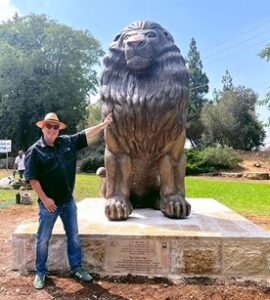By Jerry Klinger

ARIEL, Israel — Twenty years ago, I went to Ariel with Harris Gulko, the retired head of JNF Canada. We were looking for somewhere, anywhere, in Israel that was willing to receive with honor the remains of Stephen Norman, the last descendent of Theodor Herzl.
Stephen was the grandson of Herzl. He was the only Herzl to have been a Zionist. He was the only Herzl to have been to Mandate Palestine (1946) and wanted to return to help build the State of Israel.
Norman, a recently demobilized WWII British Military officer, was specifically barred by the British from returning to Mandate Palestine to help the Jewish people because he was a Herzl. The last thing the British wanted was a leader, even a symbolic one, for the Jews.
Norman committed suicide in Washington, D.C., after becoming deeply depressed when he learned his family had been exterminated in the Holocaust. He was a Herzl and could not do anything to help the Jews trapped in Displaced Person’s Camps.
Norman was buried in an obscure cemetery and forgotten until I found his remains. My wife framed what I had to do. She said, “If he were our son, we would bring him home.”
The ideals and the reality of Israel were shocking, sclerotic Zionism at best. No place wanted him. Even Herzl’s namesake city, Herzliya, turned him down, saying, try Jerusalem. Jerusalem was not responsive. Only Ariel said to come and talk.
Ariel wanted Norman. Having his bones buried in their soil was a needed, affirmative, Zionist political message for Ariel. The Zionism of Herzl was changing, divisively fragmenting. In Israel, “settlements,” such as Ariel, were increasingly seen as obstacles to peace and not as bastions “for” peace by the Left.
After seven years of incredible frustration, effort, money, and myopic focus, Stephen Norman was finally reburied with his family in the Plot for Zionist Leaders on Mt. Herzl.
Because of Norman’s situation, Rabbi Shlomo Moishe Amar, the Sephardic Chief Rabbi of Israel, issued a Rabbinic ruling that changed Judaism.
After Rabbi Amar’s questions were answered and the appropriate evidence and medical reports submitted, Rabbi Amar ruled that suicides, such as Norman’s, were to be acknowledged as illness. Stephen was granted the right to a proper Jewish burial as anyone who died because of disease.
Mental illness is an illness.
Theodor Herzl and his family, tragically, struggled with genetically transmitted depressive illness.

Bringing Norman’s body to Ariel was idealistic, but wrong…. Bringing the Lion’s Trail to Ariel was right.
Ariel is an Israeli city of 20,000, primarily Jewish residents. Its name translates as “Lion of God.” It is located twelve miles east of the “Green Line” and twenty-one miles west of the Jordan River, pretty much in the center of the horseshoe-shaped area Palestinian Nationalists call the heart of their homeland, the “West Bank.”
The “Green Line,” literally a green line drawn on a map of the 1949 Armistice Agreement, temporarily halted fighting in the “West Bank” during the Arab-Israeli War of Independence. The “Green Line” demarcated the positions of the Iraqi and Jordanian armies, local Arab militias, and Israeli forces.
The “Green Line” was not intended as a permanent border between the Arabs and the Israelis. The permanent border was to be negotiated at a future time.
Unilaterally, Jordan annexed the West Bank into Jordan in 1950. Four years later, in 1954, it extended Jordanian citizenship to its Palestinian residents. Only Great Britain officially recognized the annexation. The U.S. quietly acquiesced to the facts on the ground.
The “Green Line” never stopped Arab Fedayeen and terrorists from crossing over into Israel to kill and destroy. Nor has it stopped counter-insurgency responses from the Israelis.
In 1967, Syria, Jordan, Egypt, Iraq, and local Arab militia combined forces to militarily destroy Israel. Israel warned Jordan not to join in the war effort. They did not want another front to fight.
For Jordan, the West Bank “Green Line” border was a tempting strategic opportunity to split Israel in two. From the “Green Line” to the Sea, Israel was extremely vulnerable. Israel was only nine miles wide near Netanya. Israel could be choked to death.
Jordan refused to heed the warning.
Spectacularly, some say with Divine intervention, Israel defeated the combined might of the Arab world in six days, “The Six-Day War, June 5-10, 1967.” The West Bank fell to the Israelis.
One month after the capture of the West Bank, Yigal Allon proposed to the Israeli cabinet to return most of the West Bank to Jordan, possibly creating a demilitarized Palestinian State. Allon’s plan envisioned retaining 1/3 of the captured land. Militarily, the plan was to protect Israel from potential invasion from the East by creating Jewish settlements and forward listening areas along and through the Jordan Valley.
King Hussein of Jordan and the Palestinian leadership rejected the “peace” proposal.
With Israeli cabinet-level approval, Ariel was born out of necessity in 1978. Forty families, led by Ron Nachman, later long-term mayor of Ariel, settled on barren, unpopulated land close to multiple biblical-era Jewish communities.
Ariel grew quickly, becoming the “capital” of Samaria, the Biblical name for the West Bank. For the first time in nearly 2,000 years, the exiled Jews had returned to the “Land.”
The West Bank/Samaria is filled with Jewish archeological sites. Jews have persistently lived in the area, returning after repeated conquests and expulsions by invaders, the Assyrians, the Babylonians, and the Romans.
With Biblical King Solomon’s death, the ten tribes of Northern Israel, subjugated to the centralized, exploitative control of the tribes of Judah and Benjamin in Jerusalem and religiously dominated by the Jerusalem Temple-centered theocracy, revolted. A separate Kingdom of Israel emerged in Samaria, with a separate Kingdom of Judaea in Jerusalem.
The weakened Kingdom of Israel fell first to the Assyrians, who, with particular cruelty, ethnically cleansed Samaria of its Jewish leadership, leaving the peasant farmers to struggle on. Next, the Assyrians conquered and destroyed the Kingdom of Judaea and sacked Jerusalem, laying waste to the Temple.
The Babylonians and, later, the Romans conquered all the lands of the 12 Tribes of Israel. Jewish life, dispersed throughout the Middle East, even with the rebuilding again of the Jerusalem Temple, struggled.
Jewish life never began to recover in Samaria until Ariel was founded. Like many of the “settlers” in Samaria/West Bank, the founders of Ariel were imbued with a unifying belief. That belief sticks in the face of the Arab officer who joyously proclaimed after Jerusalem’s Old City fell to the Jordanian Legion in the Arab- Israeli war of 1948, “For the first time in 1,000 years, Jerusalem is free of Jews.”
The Jewish “settlers,” extremists to some and patriots to others, share a unifying belief: Jews have a right to live in their ancient homeland.
Will Israel listen to Abraham Lincoln’s 1858 warning to America?
“A House divided cannot stand.”
Will October 7 change things?
The plaque accompanying the Lion of Ariel reads:
Oh, Ariel, Ariel, the city where David settled! Add year to year, and let your cycle of festivals go on…” Isaiah 29:1
The Jewish People have lived here for over 3,000 years.
Donated by the Jewish American Society for Historic Preservation in cooperation with the City of Ariel.
Sam Philipe: Sculptor
*
Jerry Klinger is the President of the Jewish American Society for Historic Preservation.